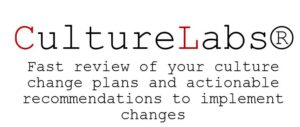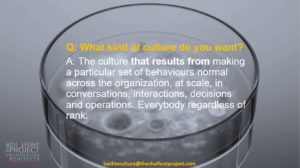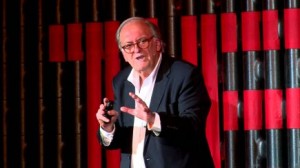|
|
|
|
|
|
|
|
|
|
If you want to have a conversation about the future of work, the nature of work, the post-pandemic work, the overrated back to normal, don’t start with hybrid versus non-hybrid, flexible versus non-flexible, zooms or no zooms, work from home or work from anywhere. It’s the wrong start.
The conversation is about the culture you have, want, need, hate, want to reshape. The culture as the petri dish where everything grows, good or bad. Focus on culture. This is the real driver. This is the true conversation.
If the post-pandemic triggers any conversation at all, culture is the literature. Workplace is the grammar.
The culture of your company is your workplace now. If anything, the workplace/place and space of work, is within the culture. Culture is not something within the workplace.
Culture first, number of zooms and number of days within the office walls, second.
I for one think that those physical walls and corridors are incredibly important. But this is a grammatical issue.
___________________________________________________

Petri dish is the company culture, where everything grows.
Imagine that everybody did (behaviour here), that it became the norm, a routine; what kind of organization would we be building? This ‘imagine if’ test is at the core of the way we need to map behaviours.
Culture is not a closed container of things such as beliefs, attitudes, values, behaviours, and logos. Intellectually it may be stimulating to use all these terms but pragmatically other than the visible logo the only other observable things are behaviours.
________________________________________________
 Webinar: The Myths of Cultural Change
Webinar: The Myths of Cultural Change
Watch now [3]
 New from The Chalfont Project – a simple and carefully crafted vehicle, offering
New from The Chalfont Project – a simple and carefully crafted vehicle, offeringWe often hear the need to put some order in Division A, or to restructure X and Y by putting them under the same roof, or to address the strong mis-alignment of Division B. This kind of conversation can go for ever with all people conversing going in circles, wishing somebody would decide to strike.
Not unusual, in my experience, that the conversation remains at a high level ‘process and systems’: Division A is persistently difficult and not responding adequately to commercial needs; X&Y not talking to each other and leaving all of us suffering the consequences; Division B lives in cuckoo land whilst the rest of us need to pick up the pieces. There is consensus!
When I have tried many times to bring the conversation to the next level down, (behaviours, as you would expect me to do), the panorama unfolds towards a very different situation. Now we have plots and characters. So, that bunch around Division A, the two infamous project leaders of X&Y, and the new manager in Division B, these are the culprits.
Suddenly, a catastrophic failure of organizational structure that was begging for full restructuring whilst consuming a lot of collective energy, has been reduced to the behaviours of a few names and surnames. Now we are talking.
If I push the envelope and ask for a picture in which those names and surnames, usually a handful, and, believe me, in many cases one, could be surgically removed, then I see lots of aha! and lots of smiles, and signs of true happiness, freedom, liberation, you name it.
So the problem is not that Division A is persistently difficult and not responding adequately to commercial needs, is it? It is Peter, isn’t it?
And not that X&Y are not talking to each other and leaving all of us suffering the consequences. Do we mean that Mary and John hate each other, and don’t talk to each other?
And is the entire Division B that lives in cuckoo land whilst the rest of us pick up the pieces, or is John the new guy in charge the one in cuckoo land?
Our tendency to play a, mostly unconscious, ‘halo effect’ that bypasses the hard(er) task of calling a problem by the name on the passport, is quite incredible.
I wonder how many Big Reorganizations by the hand of the Big Consulting Groups could have been or could be avoided by Minimal Invasive Surgery.
And you would be back home for dinner.
________________________________________________________________________________________________
Yesterday’s Daily Thought [7] introduced the formula:
(1) Space in the World (Purpose) + (2) Core Beliefs + (3) Non negotiable Behaviours + (4) Organization Logic (Basic People Algorithms) = (5) Company Constitution
What is the Organizational Logic? It is the set of People Algorithms that constitute the basic Code under which the company needs to operate.
Example of the algorithm: ‘If there is problem in A, it is solved in A and not escalated to B, unless X happens’. Rule: an algorithm needs to fit into a maximum of two lines. These are like the code of the operating system. Rule 2: you must have a maximum of 10 algorithms in the company. In a large set up you may need some extra for specific areas, but you should never go beyond 10-15 basic algorithms. If you find yourself going that way, you are writing literature, not grammar.
No, this is not the complex ‘governance’ structure usually reserved to describe ‘who does what’ and who is allowed or expected to make particular decisions, a Rights System. The algorithms sit lower than that, underneath it all, at DNA (values, non negotiable behaviour) level. Organizational logic is to Grammar what Governance is to Literature.
To reiterate, ‘If there is problem in A, it is solved in A and not escalated to B, unless X happens’ is an algorithm. ‘All projects in Product Development are reviewed every month at a Product Review Committee, whose members are F,G,H’, is governance.
What is the connection between beliefs and the logic? In the example above, the belief is that people should be empowered (and that people will accept the empowerment) to deal with ‘A problems’. An opposite belief is, ‘we don’t trust people to do that, so we promote escalation’.
In an escalation system of beliefs, everything goes up and ends up with the Board. Or it does not. Interestingly, escalation cultures create their own unintended consequences of self-defence. Knowing that everything escalates, secrecy and ‘protected bubbles’ appear, and subtle (or not that subtle) conspiracies of silence are generated. Example: the banks. Ok, some banks. Despite their monolithic appearance to mortals like myself, many banks are organised in tribes: ‘the traders desk’, ‘the retail group’ etc. Many recent big fiascos have taken place at ‘trading desks’ that self-protected themselves (as good tribes do, after all, it may be you next time) and they ‘did not escalate’ issues or dealings in ‘grey areas’.
Spending time and investing serious leadership efforts in establishing ‘The (Organizational) Logic’, shortcuts months of alignment in the maturity curve. Usually it all starts with ‘it will be impossible to write the Logic down’, or ‘there will be dozens, if not hundreds, of algorithms’. Once a bit of settling in has taken place, this upfront panicking reduces and people progress, with joy, to the discovery of the very few lines of ‘code’ that should inform everything.
Next is ‘Non Negotiable Behaviours’.
________________________________________________________________________________________________
Conversations about the future of work, don’t start with hybrid vs. non-hybrid, flexible vs. non-flexible, work from home vs. work from anywhere. It’s the wrong start!
The real conversation is about the culture you want or need. Company culture is the petri dish where everything grows. The culture has workplaces. Focus on culture. This is the real driver. This is the true conversation.
We want to hear from you!
What current culture challenge is your team/department/organization facing? Send your number one challenge to us and we will come back to you individually with some expert resources from our extensive experience in behavioural and cultural change. Email your challenge to: [email protected] [8]
For more complex challenges, we would be more than happy to discuss these with you. Email us at: [email protected] [9] and one of our team will be in touch.

If I had a say in new roles for large organizations, I think I would establish this new Division:
Just kidding. The last thing we need is another armoured Division in a divided organization.
But the principal is still nagging me. A lot.
In many organizations I know, the enemy is within. It’s called self-inflicted complexity. And that self-inflicted complexity is often justified by the real complexity of the business, the environment, the operations.
It’s a self-fulfilling prophecy.
Waste (of time, of ideas, of hope) accumulates.
Noise (rumours, second guessing, sense of apocalyptic events just around the corner) increases. In some big cities, traffic has been banned due to pollution. Corporations take note, it’s not about the level of sulphur dioxide or carbon monoxide in the air, but the other pollution: negativism, procrastination, and monkey-passing amongst other toxic particles.
And you might have noticed that some issues never go away, they disappear briefly through the door, but come back through the other side immediately. It’s a revolving door. They refuse to go. Like some consultants. (A very funny client told me once that they had finished a long time ago a big mother-of-all-restructuring projects via that Big Consulting Company, but the consultants were still in her office).
There is an alpha-men-and-women busy-ness that shows how important we all are, and how difficult the issues on the plate are, and how many stakeholder-constituencies-people to please we have to consider. Frankly, in some cases it feels Herculean.
However. Is it?
The problem with self-inflicted complexity is that one is so busy dealing with it that we miss the real objective complexity. Then we add the salt and pepper of noise and recycled items, and the entire company becomes a gigantic HiFi. If the aliens are listening and looking for clues, they will surely receive those signals and noises from our corporations, all packaged in one (since we have lost the capacity to distinguish between signal and noise).
Mmm. On second thoughts, maybe that VP office is not such a bad idea.
Reality is complex, but organizational processes need to go on a diet, so that humans can actually talk to each other.
________________________________________________________________________________________________
This series explores the future of organization life. We will explain how the 3 Pillars of The Chalfont Project’s Organizational Architecture – smart organizational design, large scale behavioural and cultural change and collective leadership – work together to create a “Better Way” for organizations to flourish in the post-COVID world.
Feed Forward Webinar Series [11]
In this series, Dr Leandro Herrero and his team of Organization Architects debunk uncontested assumptions and uncover the alternatives, whilst considering why this is even more relevant today in the current exceptional environment.
_______________________________________________________________________________________________
Attention re-structuralists, strategists and people about to be sold a multi-million pound reorganization solution that will solve all those nasty problems of collaboration, customer-centrism and agility, all in one, and in one bill.
Every new structure or system designed to solve a problem brings along new and different problems which in themselves may constitute a bigger problem than the one it was intended to address in the first place.
Any structural solution (translation: new group, division, team, business unit, re-structuring, re-shuffling, re-organization) created to fit a particular problem (and perhaps sold as a perfect solution that just seems to be exactly what is needed) needs to be implemented with at least the provision to deal with unexpected consequences and paradoxical outcomes. Some will be emergent, many could be predicted.
The designing of solutions needs to address the potential liabilities of the new design. No system, including organization architecture, will be neutral. In fact, as it’s said in the ‘systems approach culture’, the system always kicks back.
Even more, there is an application of The Chatelier Principle: any process sets up conditions opposing the further operation of the process.
The solution, always kicks back.
________________________________________________________________________________________________
The new Promised Land of the so-called ‘future of work’
We know that the new organization has to be very adaptable and flexible, beyond what it has been in the past, but what are the organizational principles that can lead to that? Is there a singular best model? Or, more importantly, can several possibly competing models coexist in one single organization? And, if so, what kind of management and leadership are to be reinvented?
This webinar has now taken place. Please click on the link below to visit our On Demand page.

Sorry for the medicalisation, an annoying legacy in my brain from many years of diagnosing and prescribing.
Unlike many other ills, autoimmune diseases are generated by our own bodies. Our immune system, in charge of fighting external invaders, gets it wrong and fights your own defences. You are caught in your own friendly fire. You are attacking yourself. Rheumatoid arthritis, lupus, type 1 diabetes, inflammatory bowel syndrome, etc. You name it.
In our organizations, we have our own autoimmune diseases. Employees fight colleagues and leaders, the Unions fight management, people fight the systems they have created, HR fight disengagements blaming the disengaged. So many things look and feel as self-inflicted pain. It’s often a war place, not a workplace. With lots of war-shops instead of work-shops.
If there is a long way, we will take it, a leader told me recently. They are fighting their own simplicity.
In my experience, the worst affected by the auto-immune mechanism, are industries that are ‘very regulated’. I work with ‘very regulated industries’ all the time, pharmaceuticals, finance, banking etc. There is nothing in any regulation that says you have to take 30 days and involve 30 people to make a decision when you can do it with 3 people in 30 days. Nothing. Zero. But the ‘we are a regulated industry’ kicks in all the time.
It’s self-inflicted pain as a symptom of their own autoimmune diseases.
They are fighting their own body.
And unfortunately these conditions are chronic.
________________________________________________________________________________________________
This high intensity, accelerated intervention takes leadership teams of all levels through a process of discovery and identification of both stumbling blocks and enablers, will be followed by a clear ‘so-what’ and an action plan. Contrary to how this may sound, when the entire management team participates, this is an incredibly fast process. But it is also an in-depth one when using our tools which, amongst other things, shortcut weeks of discussions and pseudo-brainstorming. It results in alignment around a well crafted Game Plan that reflects where they see the organization/team/department in the short to medium term and a detailed commitment to action that can be tracked. You may or may not need us beyond that point in order to help you with the journey itself.
Format: in-person or virtual
Timing: 1 – 3 days depending on format
Audience: minimum 20 – maximum 40
Price: POA
For more information, and to discuss how Reboot! The Game Plan can support you and your business, please Contact Us [6] or email: [email protected] [16]
Commenting on the communist legacy, a soviet academic Oleg Bogomolov [17], who must have known a thing or two about things that swim, said ‘It is easy to turn an aquarium into fish soup, but how do you turn fish soup back into an aquarium?’.
Mmm, don’t know how you turn a fish soup into an aquarium, but I have known many organization-aquariums being converted into fish soup. Instead of relocating fishes and getting a smaller fish tank, they decided, by the hand of Big Consulting, to go for the soup. It was faster and there were cookbooks. Expensive, but there we are.
The Organizational Fish Soup has the following characteristics:
- There is no slack in the system, resources are exactly what is required to accomplish some tasks.
- People in the wrong place at the wrong time were fired, no matter how skilful they may have been to work somewhere else.
- Middle management is gone because they were the cause of all plagues.
- The ones who were not fired were offered a redundancy package that they could not be refused. The fish tank lost key talent and a great deal of company memory, but the soup tasted delicious to ‘the shareholders’.
- The fish soup was portrayed as ’being closer to the customers’ but no customer ever wanted that closeness. They were told all was done to meet their expectations, but no one recalls being asked about them.
- The transformers saw the problem moons before but did nothing and were waiting for a miracle. When the miracle did not materialise, they bought another fish tank, and then a very big fish tank, and they put all the fishes together. For a little while. The new fish tank changed logos and letterheads.
- No C-transformer was ever fired for the mess, no Big Consulting was ever blamed for the lack of critical thinking.
- Today, the soup, is in survival mode, at the best doing OK.
- Some people in the fish soup (I mean fish) want to recreate a fish tank, a new, better, slimmer and Googolesque aquarium. But nobody knows how to do it. Chances are they will call the same consultants that created the soup to now recreate the fish tank. Sure, why not?
Call me pessimistic but…
______________________________________________________________________________________________________________________________________

The new Promised Land of the so-called ‘future of work’
We know that the new organization has to be very adaptable and flexible, beyond what it has been in the past, but what are the organizational principles that can lead to that? Is there a singular best model? Or, more importantly, can several possibly competing models coexist in one single organization? And, if so, what kind of management and leadership are to be reinvented?
27th May, 1730 BST/1830 CET
REGISTER NOW [10]
REGISTER NOW [10]
REGISTER NOW [10]
New organizations and old ones in the business of transforming themselves, would be better off learning by heart these two words: aggregation – disaggregation.
This is the ability to create ‘transitional’ or ‘time-limited’ (dare I say even ephemeral) fit for purpose structures that aggregate people for a purpose and disaggregate as soon as a mission has been accomplished.
The concept is not new. Some organizations have used Tiger Teams and SWAT teams for a long time but it has mostly been a bit of an anomaly, and most of the time with an heroic-crisis-fixing goal and ethos.
I am talking here about normalizing aggregation-disaggregation as a form of transitional (proper) structure that brings brains and hearts for a reason, in a non-permanent basis. Most new structures that we create have a permanent mission (or at least not the prospect of a relatively early disbandment). Organizational chart management (and reshuffling) is done mostly on hierarchical/reporting grounds.
Entire corporate functions, for example could host those temporary aggregations (effectively people in relatively short secondments) which could attract best brains and hearts that do not need to permanently ‘move house’. In particular, people from the business side in operational functions. The difference with a Task Force is that these tend to become very bureaucratic and committee -style, whilst these aggregations are ‘for real and full time’ for the time frame decided.
Business organizations should look at the ‘movie studios’ model with different professions aggregated and coming together for a while, disaggregating as soon as an outcome is in place. It’s normal, nobody thinks the sky is falling, and you are called to arms if you are good. By the way, the director is not fully in charge and the output is frequently not his or hers, but the editor’s. That is why there is something called ‘the director’s cut’ version, or the one they would have wanted. The producer has the money and has called the director but does not direct. The casting people bring the bodies but not the location and the location people do the opposite. Composers work in parallel but don’t direct or edit. Scriptwriters usually work as a mini group and produce the script that some directors, or indeed actors, often bypass. The actors act but only in their bits, they don’t sit around waiting. And special effects play with screens. And they produce a multi-million pound output.
Just imagine for a second this application in our traditional, permanent, stable, organization-chart-driven companies. As many good disruptive ideas, the cost is anything from zero to minimal and the learning potentially huge.
______________________________________________________________________________________________________________________________________

The new Promised Land of the so-called ‘future of work’
We know that the new organization has to be very adaptable and flexible, beyond what it has been in the past, but what are the organizational principles that can lead to that? Is there a singular best model? Or, more importantly, can several possibly competing models coexist in one single organization? And, if so, what kind of management and leadership are to be reinvented?
27th May, 1730 BST/1830 CET
REGISTER NOW [10]
REGISTER NOW [10]
REGISTER NOW [10]
There is a difference between listening and just waiting to speak. You can spot people doing either. Some people don’t listen at all, just are silent until they decide to speak. Other people may interrupt – how annoying! – but actually they may listen more than the silent and polite.
‘Interrupting’ has a cultural connotation. The conventional wisdom is that this is rude. And it is, in Anglo-Saxon context for sure. In other cultures, it is more normal and nobody sees it as disrespectful. Conversations overlap and people start talking when the other has not even finished the sentence. And in those countries, last time I checked, the sky was not falling.
After many years in organizational consulting, I can spot who is listening and who is not. The management team at the back of the meeting room, secluded from the rest of delegates, looking at their laptops/blackberries/iPhone and nodding and smiling, are not listening. Actually, this ‘show of support’ by being in the room ‘despite their busy schedules’, is a waste of time and an insult to the imagination. Their engagement has the strength of a cream cake.
Other politically incorrect ‘interrupters’, as much as they are a pain, may be listening big time and engaged fully.
Don’t judge listening by the amount of silence or the amount of interruptions. Suspend judgment. Get behind what you see and hear, what people do.
The test of listening is not what is not said but the meaningful conversation, or lack of, that follows in the room.
________________________________________________________________________________________________
The new Promised Land of the so-called ‘future of work’
We know that the new organization has to be very adaptable and flexible, beyond what it has been in the past, but what are the organizational principles that can lead to that? Is there a singular best model? Or, more importantly, can several possibly competing models coexist in one single organization? And, if so, what kind of management and leadership are to be reinvented?
Join us on 27th May at 1730 BST/1830 CET
REGISTER HERE [10]
Any organization has accountability holes, areas where nobody really owns the space. Sometimes these are true ‘grey areas’, sometimes are very black, true black holes or Bermuda Triangles where things get lost.
They seem to be either empty (of bodies, of ideas, of projects), silent Chernobyls avoided by the corporate citizen, or the opposite, full of stuff that nobody wants, idea orphanages. They are to organizational and business life what structural holes are to networks, those areas of the network with very low density.
Many organizations go on and on about needing more accountability, which is very often a linguistic proxy for ‘for goodness sake, do what you are supposed to do’.
HR complains that nobody knows whether employer branding is theirs, or if it is part of Corporate Communications. Internal communications thinks that Employee Engagements should be theirs, but HR pays for the survey. Strategic planning is driven by Finance but they don’t really feel they should other than taking care of the numbers. Organizational life is often a life of corporate ping-pong.
The above are not, by any means, the most problematic cases one can find because, one way or another, somebody may be doing something about them, reluctantly or not.
But there are many other situations where the-indecision-is-final seems to be the permanent state of equilibrium. Here are the black holes.
Interestingly, in the English language, the word accountability is often linked or even proceeded by the word ‘taking’. So, taking accountability, literally means that, an active appropriation effort, not passive receiving. Unlike ‘empowerment’, or being empowered, that always sounds as something you get from somewhere.
The cure for accountability holes, Bermudas and Chernobyls, is pure Occupy-The-Street activism. Bring the tent and occupy the space. Chances are the people on the 10th floor with the organizational charts have no clue as to what to do with those accountability holes, that is why (sadism excluded) they have not put names and bodies and reporting lines.
In organizational life there is a surprising lack of Horror Vacui (fear of empty space). Ideas and potential projects can be left wandering around, nomadic visitors, always avoiding those accountability holes which remain, oh, well, a hole.
There is however, a possibility that at some point, somewhere with decision power, the tolerance reaches a threshold point and the territory becomes occupied by decree. Be careful what you may wish to be waiting for, you might get it. But in many cases this is only happening because the power holder suffers in fact from Horror Vacui and can’t stand the hole. Not to draw disrespectful parallels but, in my previous life as a psychiatrist, Horror Vacui was a feature of seriously ill schizophrenic paintings in which every single inch of a canvas given to patients to express themselves by drawing stuff, gets completely filled in. No inch left blank. Only schizophrenic patients master that.
I am told often of an ill constructed mixture of prudence and respect, avoiding stepping into somebody elses shoes, as justification for not ‘stepping in’. But the problem is that those shoes are nobody’s and very often, they have not even been taken, ever, out of their box.
In my experience, I would go the opposite route: occupy! You’ll be surprised how many people feel relief. OK, perhaps some are a bit jealous that you have done it, but, hey, that is a precedent to copy.
Seriously, buy the tent.
________________________________________________________________________________________________
Join my team of organization architects and I, as we explore the future of organizational life. We will explain how the 3 Pillars of The Chalfont Project’s Organizational Architecture – smart organizational design, large scale behavioural and cultural change and collective leadership – work together to create a ‘Better Way [10]‘ for organizations to flourish in the post-COVID world.
REGISTER NOW [10]
REGISTER NOW [10]
REGISTER NOW [10]
Behavioural/cultural shaping in organizations does not scale up by the leaders simply having the right mindset and motivation. A mechanism (mobilizing platform) must be in place. Many reasonably good leaders think (they have been told by providers of leadership development and HR departments) that having a good (massive?) spread of leadership workshops (programme) and coaching to key people, things will naturally scale up. This is false maths.
I sustain that leadership in large organization is (must be) always leadership of social change following the socio-behavioural rules of social movements and not the traditional leadership programme cascades. Another thing is team alignment or collective leadership at, for example, leadership team(s) levels and/or the individual coaching. These things are great but not scalable.
No practitioner in culture change can ignore ‘scale’ since culture by definition is something that has scaled, good or bad. Even if commercially we see a lot these things coming together , ‘culture’ and ‘leadership’, they are very different things. Good leaders are not automatically good leaders and shapers of cultures, although they are on a good path, compared with the alternative.
So, knowing how things scale or not, is vital to the practise of ‘culture change’. Our well known distinction between World I (the world of communication) and World II (the world of behaviours) serves to at least be clear on what to expect or not.
It may be that you, as leader, have reached a good level of insight, self-introspection and learning. It may be that you are well equipped with good emotional and social intelligence. Great! Still you have a big question to ask: can you scale that goodness? Will that A, B, and C initiative scale up, or will they be something nice and good and rewarding in the relatively safe and relatively small world around me?
Don’t have a good scale answer? Don’t stop what you are doing, but ask, where is the multiplication, not the addition? Where’s a pull effect, not another push? How can we engage the other 1000 people?
Here is the logic for a Mobilizing Platform [18], not a change method, but a way to provide a scale up effect/social movement.
________________________________________________________________________________________________
I have crafted a special webinar for Board and/or Executive Team members of organizations, and their institutional investors. Visit Executive Webinar [19] for full details and to reserve your place on Thursday 13th May, 1730 BST/1830 CET.
“I get your strategy. Now tell me how your culture is going to deliver it. Also, how that culture shapes the “Social” in your ESG (Environmental, Social, Governance) agenda”.
Visit Executive Webinar [19] for full details and to reserve your place.
This webinar will cover:
I, along with my team of Organization Architects from The Chalfont Project [12], will explain how to orchestrate culture change successfully.
This is the request we make at the beginning of a Viral Change™ [13] programme. Forget your function and your hierarchical position. You are participating in the social movement representing yourself. The leadership of the organization has asked you to participate and you are a champion/activist, holding a key role because of who you are as a person, not your role description. And, if highly connected and influential champions have been found via anonymous peer nomination (as we do) then your power is significant, whether you are a manager, a supervisor or a porter.
There are not many instances in organizational life where people are called to help towards a mission, which is not dependent on their position in the organization chart. It’s novel, to say the least.
The role description that people have and their hierarchical position in the system, dictate pretty much what they do. But those glasses (those sandals) de facto limit them. A community organizer, sports school coach or organizer of an amateur theatre group in the evenings, has unique skills and qualities that maybe completely lost at 09:00 am every day as soon as they wear the Health and Safety supervisor’s hat, for example.
We need to engage more and more people for who they are, and that entails a serious desire to find out! It’s extremely healthy to ask, what would Peter look like (do or say) if he left his HR sandals at the door? It would be magic to try.
________________________________________________________________________________________________
Join my team and I for these forthcoming webinars:
Join my team of organization architects and I, as we explore the future of organizational life. We will explain how the 3 Pillars of The Chalfont Project’s Organizational Architecture – smart organizational design, large scale behavioural and cultural change and collective leadership – work together to create a ‘Better Way [10]‘ for organizations to flourish in the post-COVID world.
REGISTER NOW [10]
REGISTER NOW [10]
REGISTER NOW [10]
In my work as Organization Architect, I have dealt with clients of many sizes, shapes and colours over the years. I cannot survive, let alone cutting edge lead, without a true inquisitorial engine running all the time. I have one. I claim no credit. I need one like an astronaut needs a special suit.
I know that as soon as I land in a corporate environment, anywhere, on my own or with my team, I will be inundated by answers; some of them waiting for me, ready made, sophisticated, tried and tested, declared as the truth, beautiful, ugly, poor, rich. The issue is not the abundance of answers but the quality and relevance of the questions.
I find myself frequently asking the same questions (to myself). Studying my own list is one of the healthiest things I do to keep me fit. My gym.
Here are my Frequently Asked Questions to myself (the list will self-update from time to time!):
The mapping of your own FAQs is far from anecdotal. It tells you about your ability to hear, to sense, to feel, to not accept the reality at face value. It also helps you uncover your own worries, your own sensitivities.
Have a go?
______________________________________________________________________________________________________________________________________
 Join me for a series of webinars, as my team of organization architects and I, explore the future of organizational life. We will explain how the 3 Pillars of The Chalfont Project’s [12] Organizational Architecture – smart organizational design, large scale behavioural and cultural change and collective leadership – work together to create a ‘Better Way [10]‘ for organizations to flourish in the post-COVID world.
Join me for a series of webinars, as my team of organization architects and I, explore the future of organizational life. We will explain how the 3 Pillars of The Chalfont Project’s [12] Organizational Architecture – smart organizational design, large scale behavioural and cultural change and collective leadership – work together to create a ‘Better Way [10]‘ for organizations to flourish in the post-COVID world.
27th May, 1730 BST/1830 CET
The new Promised Land of the so-called ‘future of work’.
We know that the new organization has to be very adaptable and flexible, beyond what it has been in the past, but what are the organizational principles that can lead to that? Is there a singular best model? Or, more importantly, can several possibly competing models coexist in one single organization? And, if so, what kind of management and leadership are to be reinvented?
REGISTER NOW [10]
3rd June, 1730 BST/1830 CET
The right Organization Operating System can host change, transformation, deployment of values and leadership, mobilization of people, reshaping of a culture, employee engagement and any other day to day need of the organizational architecture.
Viral Change™ [13] provides that platform – creating the behavioural DNA for the organization. With that DNA and the appropriate mechanisms of scale up, change is possible. But change is not a project or a programme, it’s a way of life.
REGISTER NOW [10]
17th June, 1730 BST/1830 CET
At The Chalfont Project [12], we prefer the use of the term ‘practicing leadership’ to ‘developing’ it to emphasise the real life essence of leadership. So much has been written that the world is full of recipes and techniques, examples and role models. The rich plethora of available answers obscures the need to have good questions. Reflection and introspection seem like logical ingredients for being a good leader, yet our business and organizational life treats them as luxuries that have no place in our ubiquitous ‘time famine’. Busy-ness has taken over business and leadership has been commoditised to a series of ‘how to’. Yet, there is hardly anything more precious in organizational life than the individual and collective leadership capabilities.
REGISTER NOW [10]
The monastic tradition in the Christian world has these 3 magic S that have been present since the Fathers of the Desert, the 3rd Century, mostly hermit monks in Egypt: Silence, Stillness and Solitude. They were never ‘packaged’ like that, just found each other.
In the 6th Century, an Italian monk called Benedict created a little book, with heavy editing from previous ones, called The Rule , which became a rather prescriptive manual for his embryonic monasteries. The first line on the first page starts with ‘Listen!’ The book without amendments since, is still the Standard Operating Procedure (SOP), excuse my language, for Christian monasteries across the world. And there are lots of them.
Most spiritual traditions will have some presence of, or combinations of the trio: Silence, Stillness and Solitude. Their collective power is beyond our imagination, but the challenge is how to practice them in our world today.
Silence is not meditation. Stillness is not doing yoga. Solitude is not sitting in a corner in Starbucks with your airpods on.
Silence is not the absence of noise. Stillness is not catatonia. Solitude is certainly not loneliness.
But how can we inject them? Practice them? Make them our friends?
I can tell you that they are mine. But they are annoying friends. They never come when I need them and turn up for dinner when I am not ready. I can’t domesticate them
Will our kids ever know them?
________________________________________________________________________________________________

If you followed the two previous Daily Thoughts, you would have got into the idea of ‘Managing by Segmenting Around’. I have just made it up, but I believe this is the current equivalent to the old Managing by Wandering Around.
The categorisation/segmentation is not new. What is new is that we need to be serious about ‘treating’ people differently. The organization is not equalitarian, it is not a democracy. The segments matter. The categories matter. A ‘toxic-sceptical-for-no-reason-person’ and a ‘let’s-make-it-happen-person’ don’t have organizational equality. Not in terms of influence.
In the political change, political campaigning, social movement approaches, you would not survive five minutes if you were not in constant segmentation and categorisation mood. The average (business) organization is extremely poor in segmentation. We treat all people the same: same communications for everybody, usually top down. We recognise many of these categories but we often tend to treat them as an anecdote. We acknowledge the existence of the chronic sceptical, and the noise amplifier, and the high connected good role model, but we give them the same treatment particularly in terms of communication. This is nonsense.
Human Resource management, which, by the way it is not a function but all of us, means recognising those differences and acting differently with the segments and categories
In political campaigning – let’s take the US presidential elections as an easy case study – you don’t go to a 60 year old with messages on unemployment and a 27 year old with messages about Medicare. It’s the other way around. Both need to be engaged for the purpose of electing ‘him’ or ‘her’, but the clicking mechanism is miles apart. In the (business) organization we simply don’t distinguish. All our HR systems care about is performance: average, terrible, contributor, outstanding, etc. These say nothing about influence, impact, power, toxicity or injection of sanity. The performance segmentation is a machinery segmentation.
This needs to change. It’s not rocket science.
Pick a few of these categories. I’ve done this for you from the previous Daily Thought, as an example:
In The Managing by Segmenting Around school of thought, you must have at lest ten different people strategies for ten different segments. Don’t mix them up. Yes, sorry, I forgot, it’s hard. That is why we don’t do it and apply the pseudo-equality concept, married to a bizarre concept of ‘fairness’ all the time. Exactly the equivalent of warning a 27 year old US citizen about cuts in Medicare, and an 60 year old US citizen about the perils of joblessness.
________________________________________________________________________________________________

Yes you can. You can have a diagnosis. Learn how our online product 3CXcan [22] provides this analysis based on the highest scientific principles of network sciences. 3CXcan will identify your formal and information connections across your organization. In the current environment it’s important to base the recovery and the post Covid-19 organization with full understanding of its formal and informal connections, communication channels and internal collaboration. Suspend judgement about your assumptions and find the truth. This webinar will show real examples of this kind of diagnosis performed in real companies. Understanding the real organization, which may or may not be the one you assume it is, will show a completely new baseline upon which to navigate the future.
Find more information on 3CXcan HERE [22].
What attendees said:
‘Thank you for the opportunity to participate in this fantastic webinar. Both the depth of the discussion between Leandro and Carlos and the very intensive exchange in the chat inspired me.’
‘It was a great pleasure to participate in today’s webinar…. If you would have been sitting next to me, you would have seen a lot of ‘head nodding’ and heard a couple of loud ‘yes’es’ from the bottom of my heart.’
WATCH NOW [11]

Exercise: take a piece of paper and put names next to each category. Use your organization or an organization you know well. This is personal, so don’t worry about the Data Protection. This is your Leadership Protection Act in operation. If you don’t know names, or you have very, very few, you are in trouble. It means you are looking at the organization from several hundred feet high from where a forest is a forest and you can’t see anything other than lots of trees. The list below is seriously biased towards the negative. I know.
More on Monday….
_______________________________________________________________________________________________

Traditional management and a great deal of academic thinking is responsible for the colossal failure of ‘change programmes’.
To change to ‘the new normal’ we must think and act differently in the management of our organizations, particularly in the areas of change and transformation. We must abandon change as something imposed in favour of people becoming true agents. Organizations that have mastered this have been in ‘the new normal’ for a while!
What attendees said:
‘Thank you for the opportunity to participate in this fantastic webinar. Both the depth of the discussion between Leandro and Carlos and the very intensive exchange in the chat inspired me.’
‘It was a great pleasure to participate in today’s webinar…. If you would have been sitting next to me, you would have seen a lot of ‘head nodding’ and heard a couple of loud ‘yes’es’ from the bottom of my heart.’
WATCH NOW [11]

These 8, self-explanatory categories of people are the natural focus of traditional HR and management systems . They are needed for good governance. They all sit in the formal organization, similarly the traditional focus of those HR/management structures.
A list
High/medium/low performer
Talent pool member
Leadership (several layers)
(dis) engaged
Pre-retirement
New hired
Next generation leaders
Team leader/management position
The next 8 categories are off the radar screen on HR/management in a range that goes from ‘I don’t know what you are talking about’ to ‘I know some of these folks, what am I supposed to do?’ and anything in between including treating them as good/bad anecdotes, necessary evils, curiosities and ‘ok, good managers know how to deal with them’.
B list
Mavericks and rebels, even without a cause
Deviants (positive). Do things differently, have another playbook and succeed
GPAs (General Pain in the Back Side; acronym non PC)
Contrarians, because they can
Nonconformists. Good ones, less good ones, but see things through glasses nobody else has
Sceptical for all seasons
Hyper-connected. Good or bad, they spread behaviours, role model at a scale, set mountains on fire and multiply anything they get their hands on
Hyper-trusted. Multiple reasons, it does not matter which ones.
Neither list is good or bad, they are two categorisations of people. Whilst the A list refers to the visible and formal, and it’s crucial as governance and overall performance management, the B list has the potential to make or brake anything.
Entire cultures are shaped by the B list whilst the A list watches the show almost hopelessly.
An entire HR/OD/culture shaping/company building platform could be set up exclusively on the B list. There are tools and processes and systems to deal with the less powerful A list, but we treat the B list as an Amusement Park.
The B list is the Hard List.
Are you able to identify people, particularly in the B list? Beyond the anecdote? Seriously?
OK, more on this tomorrow with an extended list. Clean your glasses, you need to see it. I will suggest a simple exercise then.
________________________________________________________________________________________________

What would be wrong with buying gazelles in the first place? The answer I hear sometimes is, ‘Well, the market has plenty of elephants, elephants are strong, have experience, particularly the ones who belong to big herds of …elephants. Besides, we have always bought elephants; we know elephants, we have a whole Department of Procurement dedicated to Elephants’.
We hire people with excellent pedigrees in Big Corporate and we put them in charge of the start-up, which assets include six months funding in the bank, three guys and a telephone.
We create a new division with lots of VPs, lots of functions, lots of titles and we ask them to ‘think differently’.
We fill all the recruitment gaps in the five management teams of the five affiliates, following the same patterns and profiles, and then we get them together for a big off site to talk about ‘culture change’.
We hire ambitious, high adrenaline, no-prisoners-taken, over-achieving, individualistic, Darwinian sales people and then we ask them to work as a team.
There are always natural windows of opportunity in the decision making of the organization beyond which, any undoing will have a significant cost. And the monetary cost is not the most significant one. Training elephants to become gazelles (or gazelles to become elephants) does not sound like a good idea. But this is what we are doing all the time. If you have a window in front of you (the chance to rethink completely whether you need elephants, gazelles or no animals at all), make sure you don’t lose it!
Incidentally, I am not suggesting that ex-Big-Corporate people cannot run start-ups. I am suggesting that it takes a particular ex-Big-Corporate mind to do it and that they often underestimate the challenges of working in an almost zero-support environment. I am saying also that you can’t have it both ways: love entrepreneurship and hire Big Corporate expertise; love diversity and hire clones; love collaboration and teamwork, and choose individual contributions.
________________________________________________________________________________________________

My ideal modern organization has different characters on the payroll. If there is a payroll. These are three of them:
1. The craftsman
Perhaps nobody better than Richard Sennett [25] (Sociology, LSE, Humanities New York) has described it. Himself a good craftsman of ideas, he explains the traits: skills and care to make things well, not necessarily for its immediate utilitarian reasons, with focus on detail, perhaps on beauty, or perfection, whether in a pottery workshop or a lab. What distinguishes them most is their motivation for life time learning. I imagine strategy making as a craft, more pottery than spreadsheets. I have been using the term ‘crafting’ for many moons. I hope that the use of the language makes me become one.
2. The entrepreneur
They create things, not necessarily from zero, but look for alternatives, try, experiment and above all take risks. The term is associated with taking initiative. A passive entrepreneur checking in from 9 to 5 is an oxymoron. I want entrepreneurs on the payroll. I imagine a company of entrepreneurs and its leadership with the sole goal of creating space for them. I imagine the question ‘how many employees do you have?’ changed into ‘how many entrepreneurs do you have?’
3. The activist
Which includes the word ‘act’. Therefore not ‘Wait-ivists’, ‘Later-ivists’ or ‘once-we-have-aligned-all-stakeholders-ivists’. They understand the imperative of action; the concept of ‘agency’: take control, be in charge of destiny, express themselves. For the activist, permission was never granted, it was always taken.
OK, three more tomorrow.
________________________________________________________________________________________________
